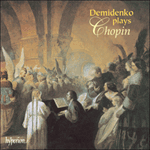Polonaises, mazurkas, waltzes, the krakowiak, the kujawiak: such are the dance types Chopin most frequently essayed. Bourrées, ecossaises, a tarantella, a bolero, are what he turned to for diversion. Conceived in the summer of 1841, the
Tarantella in A flat major has the character of a brilliantly bravura, almost Lisztian, perpetuum mobile, ripe with harmonic pungency and chromatically frenetic unrest. Niecks could find little to admire; it was, he said, like ‘a transmutation of Rossini into Chopin, a Neapolitan scene painted with opaque colours, the south without its transparent sky, balmy air, and general brightness.’ Schumann believed otherwise: ‘This is in Chopin’s most daring manner; we see the madly whirling dancers before us, until our own senses seem to reel. We can scarcely term this lovely music, but we willingly forgive the master for the wildness of his imagination, the right side of which he may certainly be allowed to display sometimes.’
from notes by Ateş Orga © 1992
Polonaises, mazurkas, valses, la krakowiak, la kujawiak: voilà le genre de danses que Chopin tentait de composer le plus souvent. Bourrées, écossaises, une tarantelle, un boléro, sont par contre les danses vers lesquelles il se tournait à la recherche d’une diversion. Conçue pendant l’été de 1841, la
Tarantelle en la dièse majeur a le caractère d’un brillant morceau de bravoure, presque Lisztien, perpetuum mobile, riche de vivacité harmonique et d’émotion chromatiquement frénétique. Niecks n’y trouvait pas grand-chose à admirer. C’était, disait-il, comme «une transmutation de Rossini en Chopin, une scène napolitaine peinte avec des couleurs opaques, le Sud sans son ciel transparent, son air embaumé et ses couleurs brillantes.» Schumann ne partageait pas cette opinion: «Cette œuvre est dans le style le plus audacieux de Chopin; nous voyons devant nous les danseurs tourbillonnant follement jusqu’à nous donner le vertige. Il est difficile de qualifier ceci de belle musique, mais nous pardonnons volontiers au maître le déchaînement de son imagination, dont nous devons, de temps en temps, lui permettre de montrer le bon côté.»
extrait des notes rédigées par Ateş Orga © 1992
Français: Alain Midoux
Polonaisen, Mazurkas, Walzer, der Krakowiak, der Kujawiak: Das sind die Tanztypen, an denen sich Chopin am häufigsten versuchte. Bourres, Ecossaises, eine Tarantella, ein Bolero werden zur Zerstreuung eingeschoben. Im Sommer 1841 geschaffen, hat die
Tarantella in As-Dur den Charakter eines brillant bravourösen, fast an Liszt heranreichenden Perpetuum mobile, reich an harmonischer Schärfe und chromatisch ungestümer Rastlosigkeit. Niecks konnte daran wenig Bewundernswertes entdecken. Die Tarantella ist nach seiner Aussage wie „eine Übertragung Rossinis auf Chopin, eine neapolitanische Szene, aber mit glanzlosen Farben gemalt, der Süden ohne seinen transparenten Himmel, seine laue Luft und allgemeine Helligkeit.“ Schumann war anderer Ansicht und sah darin Chopins kühnste Manier, die Vorstellungen von unbesonnen wirbelnden Tänzern hervorruft, bis einem die Sinne zu wanken scheinen. Obwohl man dies kaum liebliche Musik nennen könne, sei dem Meister doch gern die Wildheit seiner Phantasie verziehen, deren propere Seite er durchaus manchmal zur Schau stellen dürfe.
aus dem Begleittext von Ateş Orga © 1992
Deutsch: Anne Steeb/Bernd Müller


 Chopin: Demidenko plays Chopin
Chopin: Demidenko plays Chopin
